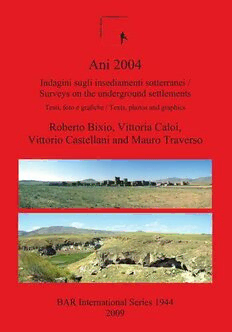
Ani 2004: Indagini sugli insediamenti sotterranei: Testi, foto e grafiche / Surveys on the underground settlements: Texts, photos and graphics PDF
87 Pages·2009·42.112 MB·Italian, English
Most books are stored in the elastic cloud where traffic is expensive. For this reason, we have a limit on daily download.
Preview Ani 2004: Indagini sugli insediamenti sotterranei: Testi, foto e grafiche / Surveys on the underground settlements: Texts, photos and graphics
Description:
The 2004 Ani (the ancient Armenian capital on the eastern border of modern Turkey) expedition was devoted to the inspection of the underground structures. The monumental town was built around the 10th century on a platform defined by deep canyons which cut the volcanic rocks of the plateau. The artificial cavities are located all along the walls of the canyons, often in two or more layers. The structures were first investigated in 1915, beginning a process of identifying, exploring and classified more than 800 cave forms. The 2004 mission checked the status of the dwellings with respect to the investigation of 90 years before, to undertake a detailed exploration of some selected dwellings chosen as term of comparison, and to investigate with special carethose underground structures which were inside or close to the city walls, in order to establish the relations between the town and the underground sites. The first chapter of the report gives a short account of the objectives of the 2004 mission, together with an overview of the relevant literature and of the history of the town. Chapter 2 deals with the settlements outside the town (the rural settlements). The underground sites inside the town walls are discussed in Chapter 3. The nature of the underground sites is discussed in Chapter 4.
See more
The list of books you might like
Most books are stored in the elastic cloud where traffic is expensive. For this reason, we have a limit on daily download.
